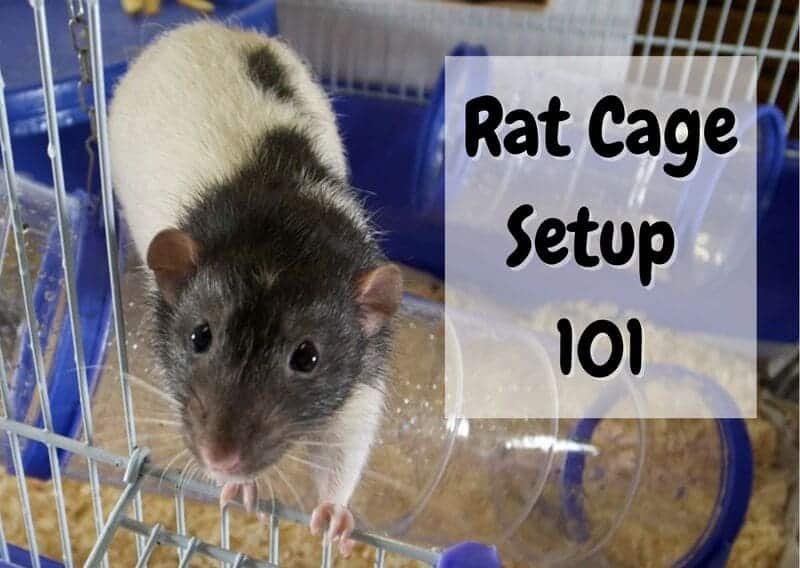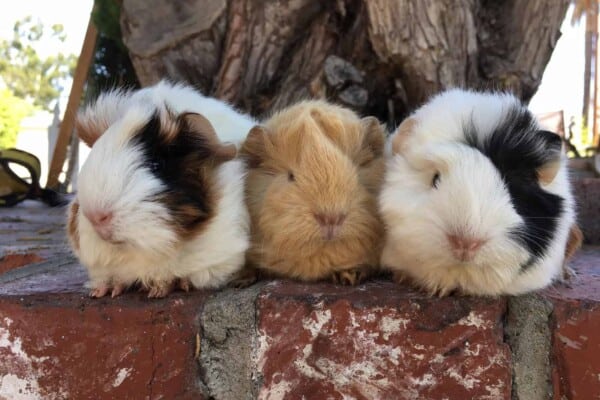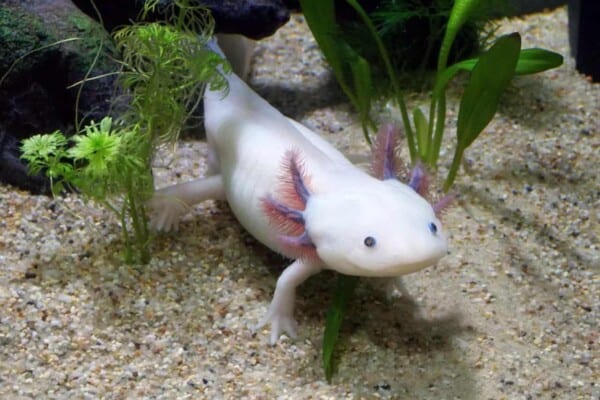Fancy rats are loads of fun, but it does take a lot more to keep them from being bored in their cage. How do you set up a rat cage in a way that will keep your rat happy and healthy?
In this guide, you will learn everything there is to know to create the perfect habitat for your fancy rats – from the cage size to the accessories and toys you can put into your rat cage.
5 Things To Consider When Setting Up Your Rat Cage
1. Cage dimensions
On average, the smallest size cage for a single rat should be 24 inches long and 14 inches wide. The height will need to be at least 24 inches tall. This is fine for a single rat since they will spend most of their time roaming around hoarding and stashing food, lint, and building their nest.
Cage size for more than one rat
If you own two rats, you can have a cage that is 2 feet long and over 1 foot wide, and 2 feet tall. These should be separated with a second level so your rats can have a separate living space. You need at least one square foot per rat to accommodate the right amount of living space.
Having both a male and female will result in rat babies unless you get them fixed. Same-sex rats will be good if you decide to pair a female with a female, but two males will end up fighting more often.
2. Materials used
Rats are very open to all sorts of things you can put into their cage, but you do need to be extra careful with plastics. Plastic is one item that rats will enjoy chewing but most plastics will be harmful to your rat. The same goes for fabric and fiber-based material, so try to avoid sewn threads and machine-made fabrics.
You can feel safe using plenty of cardboard, fleece material, shredded paper, and a variety of wood shavings. Natural rope is fine if it’s made from pure hemp, but be careful it’s not containing any kind of synthetic fiber in the center. These can cause stomach blockages which are hazardous for your rat.
3. Bar spacing
The typical bar spacing on a rat cage is tight enough for them not to escape – about 3 inches long and anything that’s 1.5 to 2.5 centimeters wide. They will try to stick their nose through these openings, but it won’t be wide enough to get their head stuck. They will need plenty of activities that will keep them busy when you aren’t handling them so they do not think about venturing out of their cage.
4. Separate levels and platforms
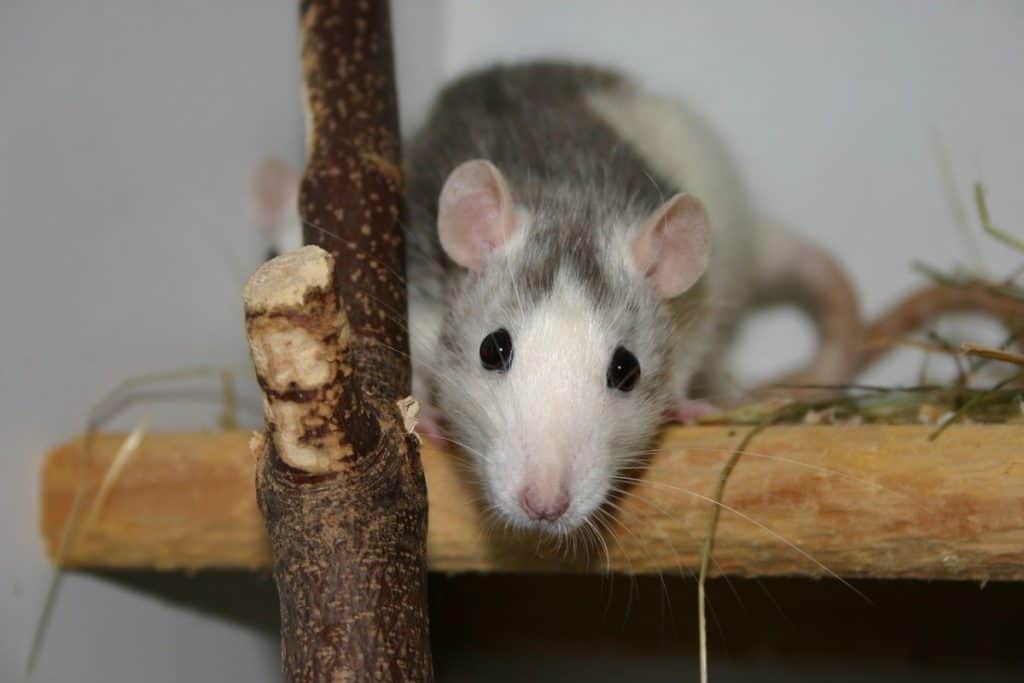
Having a separate level is a must for your rat to allow them to explore and pack themselves into comfortable spaces. Rats are naturally curious and like to create nests that are complex structures. Essentially, they are happy to have as many levels as you can create, so be open to making obstacle courses that give them lots of roaming opportunities.
These can include things that are hanging from the ceiling and may include hammocks, climbing ropes, and slings. If you include hanging hidey houses, these will be a big plus. You might be surprised how active a rat can be when you give them climbing ability in your rat cage.
5. Bedding
There are lots of wood shavings that smell good including pine and cedar, but you can’t use these with rats since they contain phenols. These are oils your rat could inhale and that can speed up natural cancers and illnesses that will plague your rat. You should buy kiln-dried shavings instead.
Paper pulp, paper pellets, and aspen shavings are better alternatives, although a bit pricier. You also need to be careful with wood shavings that contain high amounts of sawdust. You can reduce this by putting your shavings into a netting bag and shaking them outside to reduce the amount of dust.
See also: 6 Rat breeders show us how they set up their rat cages – wanna see how it’s done?
What type of accessories should I put inside the cage?
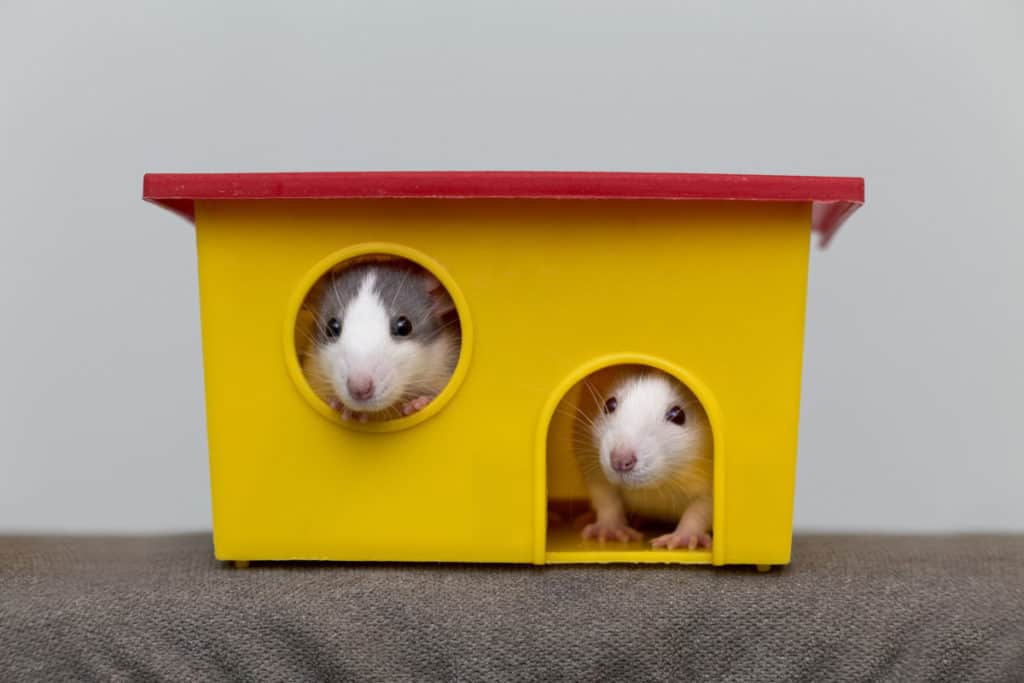
1. Hideouts
Your rat is going to love a good hideout since this is how rats instinctively like to live and hang out. Your rat likes to have a good hiding space where they feel safe whenever they need to retreat to go to sleep. This will happen out of habit, fear, or just to eat a treat.
2. Food bowls
Your rat will usually come right to their door when you give them food or treats. You may include one food bowl in your cage but it’s not compulsory. The reason is that when you put seeds in the bowl they start stashing them all over their cage.
Rats love snacks and will keep these snacks in their nest no matter where you put their regular food. If you need to have a food bowl out of necessity, this is good for putting seeds but nothing else.
3. Water dispenser or water bottle
A good water bottle is perfect for your rat. This can be a plastic bottle or glass bottle, as long as it hangs outside their cage. The dripper tube needs to be made from metal and will need to be cleaned every few days so no bacteria are growing on the end of the dripper.
Rats drink quite often water so you need a water bottle that will give them a daily allowance and prevent dehydration. Don’t give them any kind of water bowl since your rats will probably knock it over while wandering around in their cage. This will only cause messy and soaked bedding and can cause your rat to have foot problems and other health issues due to excessive moisture.
4. Hammock
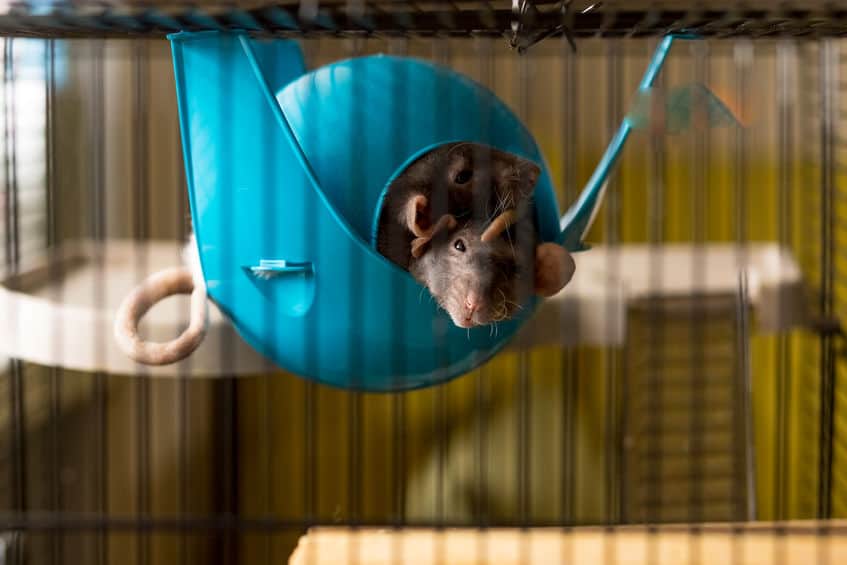
If you give your rat a hammock, it should be material that is biodegradable or made from material that will eventually be destroyed. Try making a hammock from cardboard or chewing sticks. If you need to hang a hammock, use natural hemp instead of synthetic string fiber.
Use glue that is edible like Elmer’s glue or wrap dry straw to tie together individual sticks just as you would weave a basket. At least this is safe for your rat instead of plastic or fabric materials that might trigger stomach blockages. One of the best hammocks is made from weaved dry straw that is non-toxic for them to chew.
5. Blanket or fleece
Fleece material is fine for your pet rat but you may also want to give them dryer lint. This material is completely natural and doesn’t have synthetic threads within these fluffy tufts of lint and natural cotton fibers. They will use this material to line their nest and it helps keep them warm when they take a nap.
They will be prone to chew fleece, which is their attempt to make it more fluffy or formable. Just give them a fleece that is 100% natural and doesn’t have any sewn edges that can be chewed on.
What type of toys are good choices for rats?
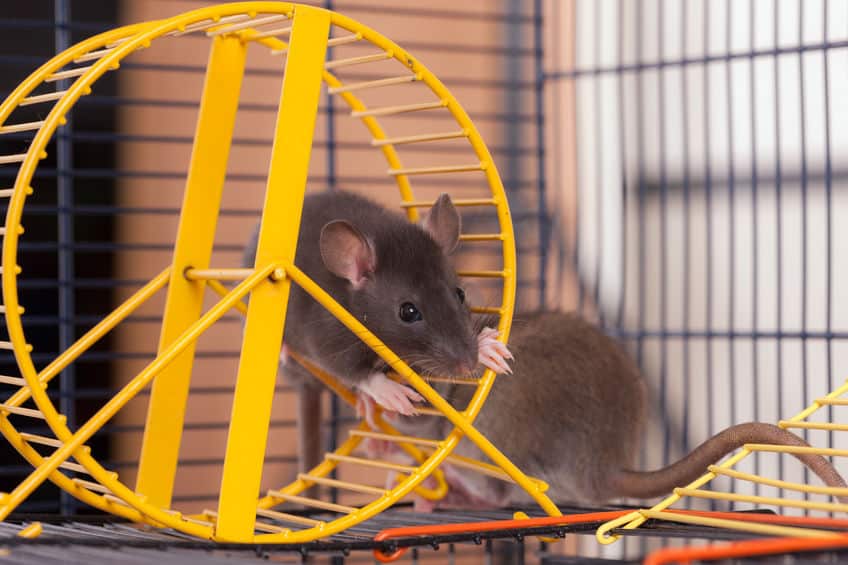
1. Exercise wheel
Your rat isn’t going to be mildly interested in a running wheel since this isn’t an activity they value too much. Female rats are more energetic than male rats so if you want to introduce them to a running wheel, make sure it is big enough for a rat – at least 12 inches in diameter so that they do not need to arch their body while running.
Rats love roaming so the best exercise item you should buy is a roaming ball. You might be more entertained by their curiosity moving around the floor. Just be careful if you have indoor pets like dogs or cats that may startle your rat. They will freeze and probably pee inside their ball. That’s when you need to take action so this urine doesn’t get into your carpet or soak into hardwood floors.
2. Chewing toys
Rats will chew to keep their teeth from growing and need to gnaw out of habit. You can give them items that help them keep their teeth short and are going to be natural alternatives. These include rawhide, chewing stones, cardboard, and sticks, but these must be chemical-free.
Toilet paper tubes and egg cartons are the best since these are items you don’t have to pay for. Having an apple tree or peach tree in your backyard is great for giving them plenty of chewing twigs and sticks. It needs to be the type of wood that is also non-toxic, just as chewing stones often have natural gypsum and pumice.
Where should I place the cage in the house?
Rats are more active at night but the good news is that they will tend to adapt to living conditions no matter the time of day. Still, you want to find a place for them that is suitable when you sleep at night. They can be active all throughout the evening and night and this makes it necessary to find a location that is quiet and with little light.
Any extra room that is not occupied is the best place to put them. Don’t put them near windows or areas that are drafty and cold. Despite what most people think, rats are very tolerant of pets but can be sensitive to barking from dogs and loud noises. This is why you need to find a spot that gives them peace and quiet during the day and through the night.
How about temperature and humidity?
The best temperature for your fancy rats will range from 65 to 70 degrees Fahrenheit, which is otherwise described as room temperature. Rats are incredibly clever at keeping warm so you do not need to raise the temperature too much for them.
Humidity is another factor to keep your rat comfortable. Don’t put them in a room that has over 70% humidity and if you have a very dry climate the lowest you can go is around 30%. Any well-insulated room will be good for your rat as long as you have good amounts of fresh air in that room.
How often should I take my rat out of their cage?
Rats are very docile and loving critters that bond well with you over time so you can take them out whenever you want. They are a lot like dogs that want to be with you and carried around everywhere you go.
Rats do take a breaking-in period and can be trained quickly and easily in less than one month. They are one of the few fancy pocket pets that you can have out of their cage for many hours at a time. They might be happy if you have a pocket or hood where they can nap if they get too tired from handling.
How often do I need to clean the cage?
You need to do this every week and is the best step to keeping your rat cage smelling better. Rats aren’t going to be specific about where they like to urinate and will find their place to relieve themselves nearly anywhere. It won’t be uncommon that your rat will feel comfortable enough to pee on you while handling them.
Female rats are more careful than males and they will be more habit-forming to pee in one select area in the cage. With this being said, you can clean these areas daily to keep their cage smelling cleaner. But in general, once a week is the longest you want to go before changing their bedding.
Should I cover my rat cage at night?
You can only do this if you have very young and shy rats, or if your home gets very drafty at night. You need to know that you have to put a piece of cardboard that is wider at the top so the edges of the blanket don’t get near the edges of the cages. This is so they can’t pull it inside their cage and chew on it.
Where can I find cool rat cage setup ideas?
Look to the internet for lots of fun ideas including fan groups on Facebook and social media websites like Pinterest and Etsy. There is no shortage of DIY sites that you can check to get fresh ideas. I recommend looking at Youtube videos to have a good idea of what can go into your pet rat cage since these all have easy and fun decorations that don’t cost any money.
- Rats and Mice, Jennifer Frohlich
- A suitable environment for rats, RSPCA UK
Related articles
- 30+ Rat breeders share their best tips for first-time rat owners
- What do fancy rats eat?
- 7 easy steps to tame a fancy rat
- What are the most common pet rat diseases?
Contents
- 5 Things To Consider When Setting Up Your Rat Cage
- What type of accessories should I put inside the cage?
- What type of toys are good choices for rats?
- Where should I place the cage in the house?
- How often should I take my rat out of their cage?
- How often do I need to clean the cage?
- Should I cover my rat cage at night?
- Where can I find cool rat cage setup ideas?

